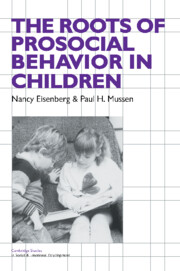Book contents
- Frontmatter
- Contents
- Preface
- 1 Introduction
- 2 Methodological and theoretical considerations in the study of prosocial behavior
- 3 Biology and prosocial behavior
- 4 Culture and prosocial behavior
- 5 “Person” variables and prosocial behavior
- 6 Socialization in the family
- 7 Socialization by agents outside the family
- 8 Cognition, role taking, interpersonal problem solving, and moral judgment
- 9 Emotional factors in prosocial behavior
- 10 Situational determinants
- 11 Conclusions
- References
- Name index
- Subject index
9 - Emotional factors in prosocial behavior
Published online by Cambridge University Press: 31 December 2009
- Frontmatter
- Contents
- Preface
- 1 Introduction
- 2 Methodological and theoretical considerations in the study of prosocial behavior
- 3 Biology and prosocial behavior
- 4 Culture and prosocial behavior
- 5 “Person” variables and prosocial behavior
- 6 Socialization in the family
- 7 Socialization by agents outside the family
- 8 Cognition, role taking, interpersonal problem solving, and moral judgment
- 9 Emotional factors in prosocial behavior
- 10 Situational determinants
- 11 Conclusions
- References
- Name index
- Subject index
Summary
Introspection will convince most people that more than cognition is involved in much prosocial behavior; often we engage in prosocial behavior because of what we feel, or what we think we shall feel, if we are kind or considerate (or what we might feel if we failed to help the needy). Feelings of concern or sadness for the needy or distressed ordinarily precede helping, sharing, or comforting, and pangs of guilt may follow a failure to act prosocially. Prosocial behavior is not usually based solely on logic, understanding, or reasoning; a number of emotions are critical antecedents of altruism.
Empathy and sympathy
Empathy and sympathy have been defined in many ways (Eisenberg & Strayer, 1987; Wispe, 1986). We define them primarily in affective or emotional terms. Empathy is defined as a vicarious affective state that stems from another's emotional state or condition and is congruent with the other's state or condition. If a girl who observes a distressed peer feels sad or distressed herself, she is empathizing. Although empathy is an emotional response, it also involves cognitive skills such as the ability to label another's emotional state or role taking (Feshbach, 1978; Hoffman, 1982, 1984).
Sympathy is an emotional response to someone else's emotional state or condition that consists of feelings of sorrow or concern for another, but does not refer to feeling the same emotion as the other person. Sympathy, which has often been called empathy, is the basis of much prosocial responding. However, because the two terms have not been differentiated in most research, we generally use the term “empathy” to signify both types of reactions.
- Type
- Chapter
- Information
- The Roots of Prosocial Behavior in Children , pp. 130 - 139Publisher: Cambridge University PressPrint publication year: 1989
- 1
- Cited by



